Protesters Describe Detention In Kenosha
Held as long as 20 hours by police, FBI. Reports of Portland-style unmarked cars patrolling city.
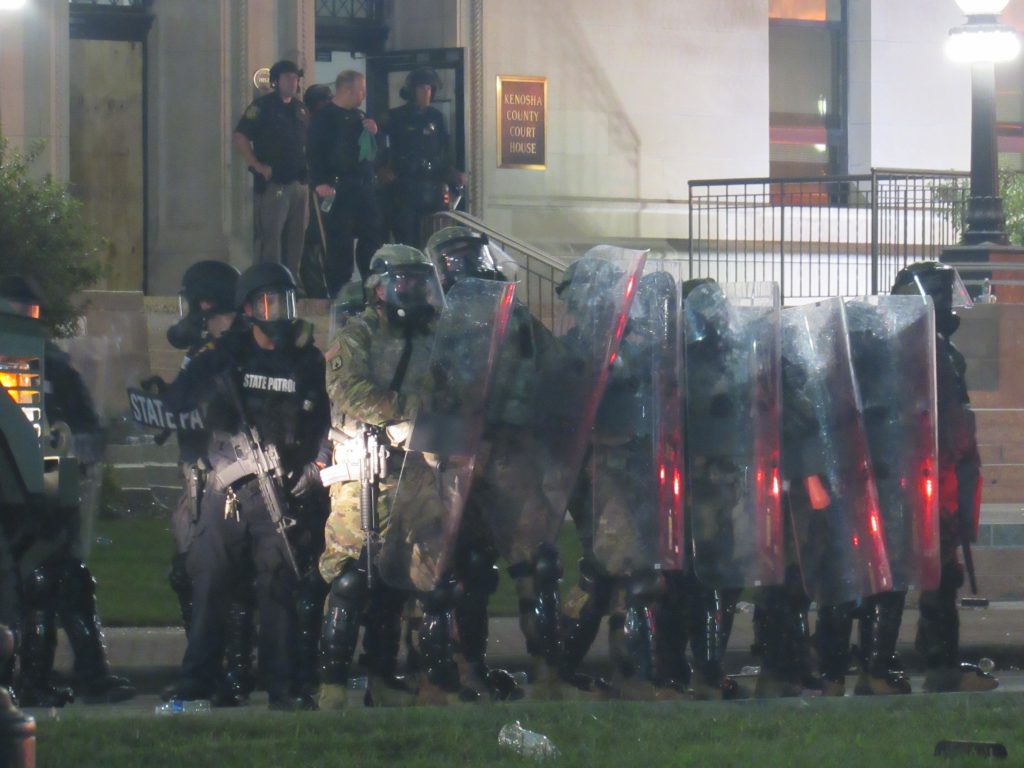
Kenosha law enforcement form up with riot shields, long rifles, and armored vehicles. Photo by Isiah Holmes/Wisconsin Examiner.
As the National Guard leaves Kenosha and the area’s curfew comes to an end, things appear to be finally calming down in the city. The past weeks of riots, standoffs with police and large-scale protests over the shooting of Jacob Blake by a Kenosha police officer have left many lingering questions. Particularly concerning to activists were reports of Portland-style arrests, which occurred in Kenosha after the curfew was declared.
Officers in unmarked vehicles patrolled the area, running down and arresting protesters and key local activists. Adelana Akindes, a 25-year-old local organizer, was one of the first prominent activists who was taken by a snatch team. Danika Gagliano-Deltgen, 19, was with Akindes when their vehicle was surrounded by unmarked police cars.
“We met up at a park near our safe house that we had established earlier that day, Deltgen told Wisconsin Examiner. Deltgen had traveled to Kenosha from Milwaukee with the goal of serving as a street medic and to deliver first aid supplies, food, masks, as well as protective equipment like helmets to groups of protesters.
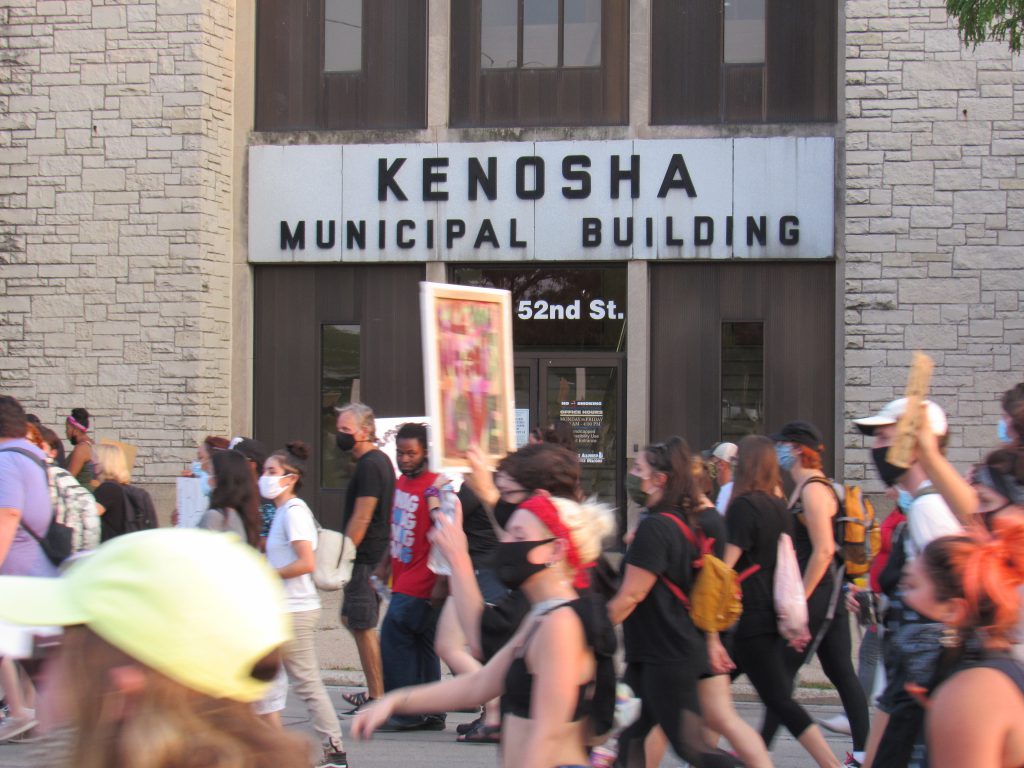
Protesters gather in Kenosha the second night of protests on August 24th, 2020. This was before the clashes with police later that night. Photo by Isiah Holmes/Wisconsin Examiner.
Although Deltgen and others were involved in peaceful protests, the situation in Kenosha was continuing to deteriorate daily. The prior night had seen the slaying of two protesters by 17-year-old Kyle Rittenhouse, and clashes with police. Deltgren, who has experience in the medical field and has taken care of her ailing grandfather, felt a responsibility to lend her knowledge to those who might need care on the ground.
“That’s why I decided to go to Kenosha,” explained Deltgren. “I’ve been doing a lot of activism over the summer with everything that happened, because I have that free time and have that ability. I usually do a lot of community service and trainings for Girl Scouts, so I’m experienced in first aid and stuff. So I decided to go out to Kenosha to do medic stuff.”
Several members of the group dropped their supplies and began to bolt, though only one of them got away. Deltgen had a bruised rib, she said, and had to stop running. “I put my hands up and I was facing a building as a car blocked me in, so I was unable to move. The National Guard came out and they physically threw me to the ground.”
Unlike the undercover officers, the National Guard troops were easily identifiable from their Army camouflage and patches. “They threw me to the ground. They took my bag, they took my mask off, and they were searching through my stuff,” said Deltgen.
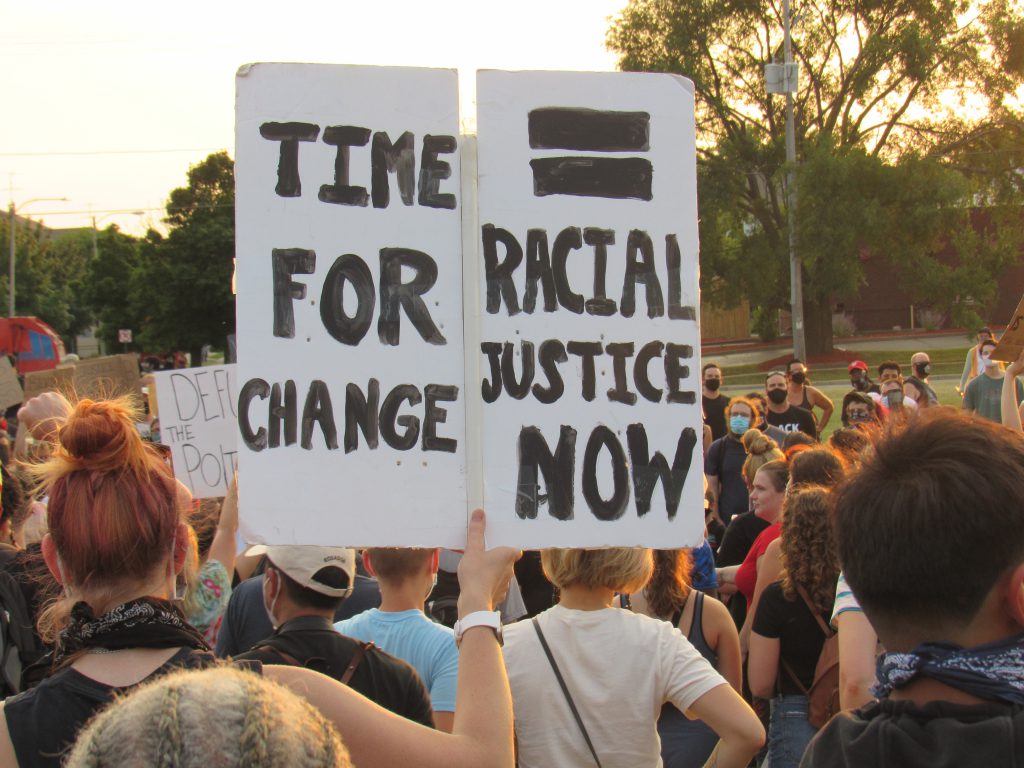
Protesters gather in Kenosha the second night of protests on August 24th, 2020. This was before the clashes with police later that night. Photo by Isiah Holmes/Wisconsin Exmainer.
On Aug. 30, the Kenosha Police Department released a brief press statement regarding its activities over the prior week. It noted that as of 12:30 p.m. that day, 175 people had been arrested by authorities. “Of those people processed during this week,” states the press release, “102 listed addresses from outside of Kenosha.” The department noted that more than 20 firearms had been seized, three vehicles had been towed, 69 people were arrested for curfew violations, 34 people were arrested for curfew and additional charges ranging from carrying concealed weapons to burglary and possession of controlled substances.
Three days earlier, KPD arrested 9 individuals from outside the state of Wisconsin. The department received a citizen tip of several “suspicious” vehicles with out-of-state plates meeting up at a remote parking lot near the highway. “Acting on this information, Kenosha police officers located the suspicious vehicles and took up surveillance,” a department press release states. Officers followed a black school bus, bread truck and minivan to a gas station where police say they “observed the occupants of the black bus and bread truck exit and attempted to fill multiple fuel cans.”
Officers surrounded the vehicles, forced entry inside, and conducted arrests. They noted that inside were, “various items including helmets, gas masks, protective vests, illegal fireworks, and suspected controlled substances.”
Although officers say they were acting on tips and arresting people who might have intended to destroy property, many felt the tactics were too sweeping. Oscar Walton, who was arrested a couple of days later with a different group, got a taste of this himself. Walton was with a small group of protesters who were standing in Civic Park, the epicenter of clashes with police during several previous nights. That night, however, things appeared to be quiet. Walton had been involved in peaceful marches during the day as well as standing protests at night which officers tolerated to varying degrees.
“We were there really not even protesting at that time,” explained Walton, “just gathered, eating food.” A Kenosha PD sergeant pulled up in a black SUV, Walton recalled. Walton said that the sergeant approached the group and asked them politely not to pitch tents or sleep in the park. He assured them there would be no arrests, Walton said. But shortly afterwards protesters nearby were suddenly ambushed. “A truck that was passing through, the cops stopped them. They swarm them, take them out, and arrest them.”
Walton and the small group he was with went to the county jail, where they demanded to speak with the sergeant. “He’s on the megaphone like, ‘If you guys go back to the civic center, then I will come and talk to you. I see that you guys are angry.’” They did as he said and the sergeant told them to get out of the street. Walton’s group obeyed, and held a “peace circle” where they shared their experiences around police and being in Kenosha over the last week.
“It was a really good session,” Walton told Wisconsin Examiner. “After about 20 minutes, we were met with at least 100 National Guard just running out of the black fence. Then you see police cars and SUVs swarming in a circle, the perimeter. We walk to the middle of the civic center to be safe and stay together.”
The group of less than 30 were warned to leave or be arrested. Penelope Hersey, a Kenosha resident and Army veteran, was with Walton’s group. She recalled the sergeant mentioning that he was associated with Kenosha PD’s gang unit. The group tried to follow the officer’s orders to leave the park while filming the entire interaction on Facebook Live.
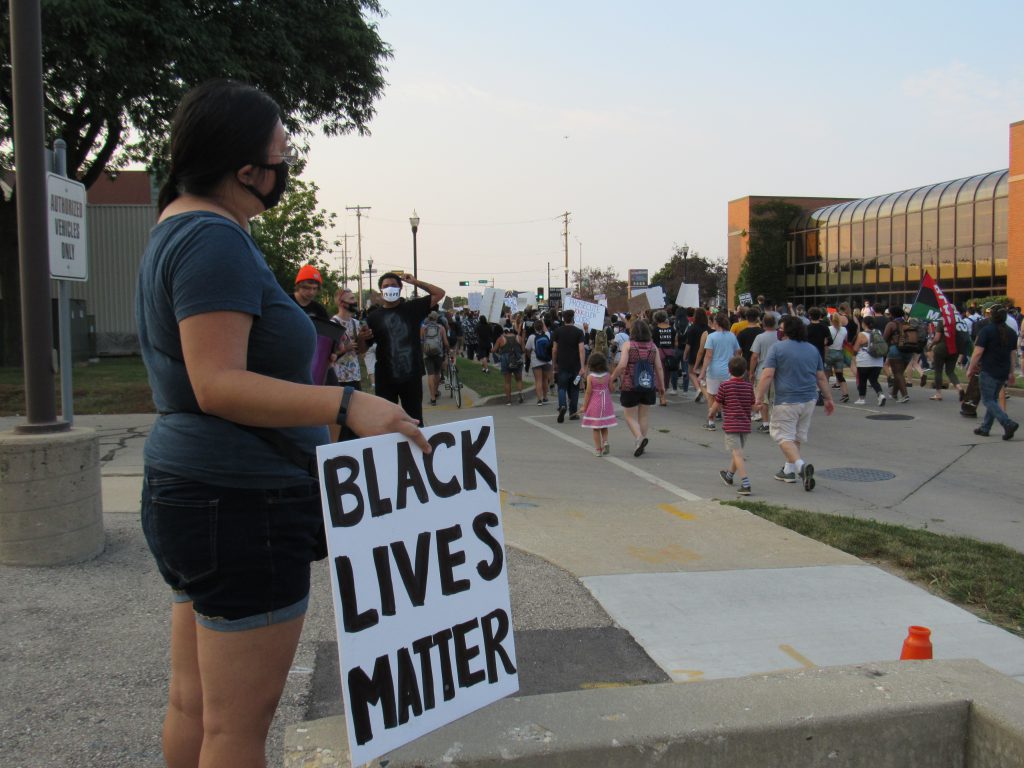
Protesters gather in Kenosha the second night of protests on August 24th, 2020. This was before the clashes with police later that night. Photo by Isiah Holmes/Wisconsin Examiner.
“Oscar had a few cops come up behind him and take him down because he was ‘walking too slow,’” said Hersey. “That’s not okay. We have a right to protest, we weren’t doing anything wrong. And whenever there is violence it’s not incited by us, it’s incited by the police infringing on our rights.” Dozens of people were arrested and jailed for violating curfew. Friends and family had difficulty finding out where they were. After locating Akindes at the jail, a group of protesters was arrested while waiting for Akindes outside the jail.
On September 1, Kenosha PD issued a press release stating that, “members of the Kenosha Gang Unit received a tip about a U-Haul truck parked facing the wrong way on a one-way street near Civic Center Park.” The truck, which the release states “contained an amount of water and supplies, but also contained materials that are consistent with rioting,” was surrounded and seized by Kenosha PD and U.S. Marshals. “After being questioned, the individuals were released,” it reads. Walton, who was arrested a day later, witnessed the U-Haul being seized, and asserts that it contained medical supplies for people continuing to protest. The supplies and U-Haul had been provided by the Zao MKE Church, which condemned the actions by authorities.
Authorities including KPD, the Bureau of Alcohol, Tobacco, Firearms and Explosives (ATF), and Wisconsin’s Division of Criminal Investigation (DCI) are working together to locate at least seven “persons of interest” to question regarding the burning of twenty buildings and several vehicles. DCI is also conducting the “independent” investigation into the Blake shooting by a KPD officer.
What happens on the inside
Not everyone was held at the same location after being arrested. While Walton was taken to the county jail, Deltgen and Akindes were driven 25 minutes away to the Kenosha Sheriff’s Detention Center. They weren’t told where they were being taken, and Deltgen was the only one with an SOS feature set up on her phone to transmit her location to her boyfriend if anything were to happen to her. “That’s the only reason anyone knew where I was getting detained that first night,” said Deltgen. “I was the first person booked.”
The protesters say their bags and belongings were searched again and their basic information was taken down. “They kept spelling my last name wrong,” said Deltgen, who added that officers put her down as white when she is actually Native American. “They said, ‘Well I don’t get why that matters.’ Like, I’m Native American. You need to put that in correctly for the records.”
Deltgen sat in a cell with Akindes, and nine other women, she said. “Five of us didn’t have masks, no matter how much we asked them during that initial intake process.” Deltgen was never questioned, and held for 12 hours before being transferred to a city custody. “I was in there for 20 hours before my booking information was fully processed,” recalled Deltgen. “No phone call, no one knew were we were, basically.”
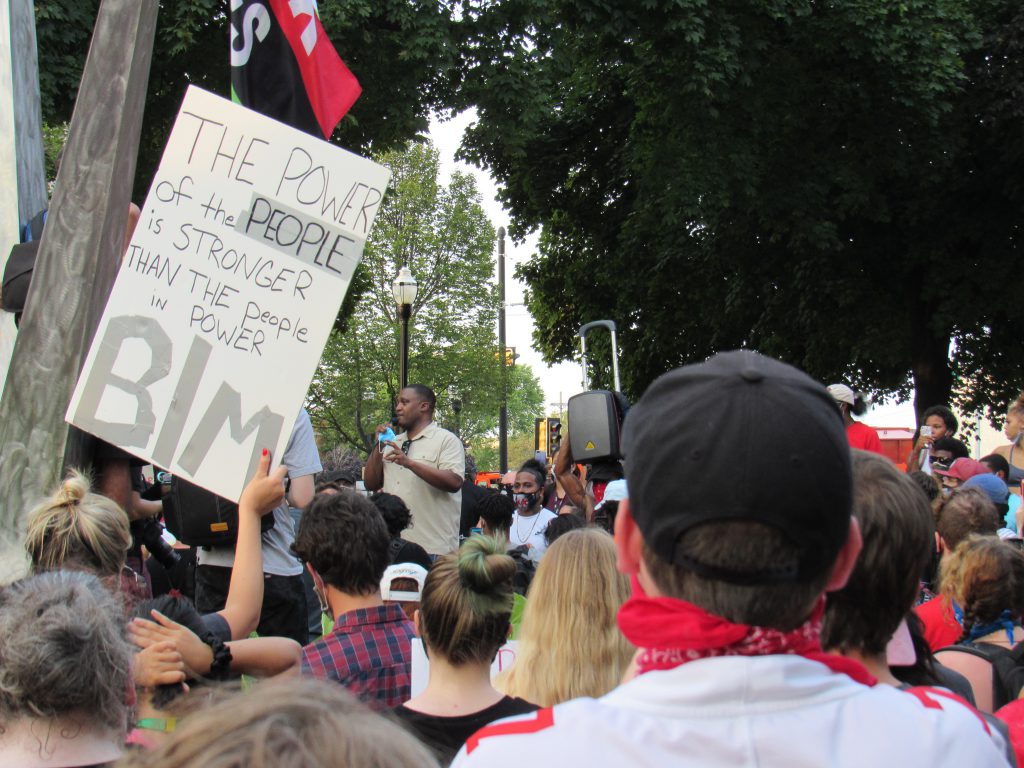
Protesters gather in Kenosha the second night of protests on August 24th, 2020. This was before the clashes with police later that night. Photo by Isiah Holmes/Wisconsin Examiner.
Walton had a similar experience, only he was taken straight to the jail and was subjected to questioning. “It started out with like eight people,” said Walton, “and by the end I was in a pod with maybe, like, 13 people at one point.”
After waiting for hours, he was interrogated by a blond female FBI agent. “She has a khaki shirt that says ‘FBI Chicago,’ don’t have no name tag,” he recalled.“They interrogated me about, ‘are you with Antifa? Who do you work for? Do you work for Black Lives Matter? Why do you chant Black Lives Matter? Where’s the next protest location?”
The agents confronted Walton about appearing in news coverage talking about the movement and leading chants. “They’re trying to treat us like terrorists,” said Walton. “When really you have the real terrorists, people like Kyle Rittenhouse just going around shooting people at will. A 17-year-old kid ain’t got no business in an open carry state carrying. But they care about people going out there chanting, ‘We’re ready for change.’”
Getting out involved further complications. Deltgren’s release was delayed, as was Akindes’ release. Walton estimates he was in jail for 12 to 14 hours. When they gave him his bags back, Walton stated, his bags were labeled “BLM.” Deltgren and Walton described similar experiences, even though they don’t know each other and weren’t in the same group.
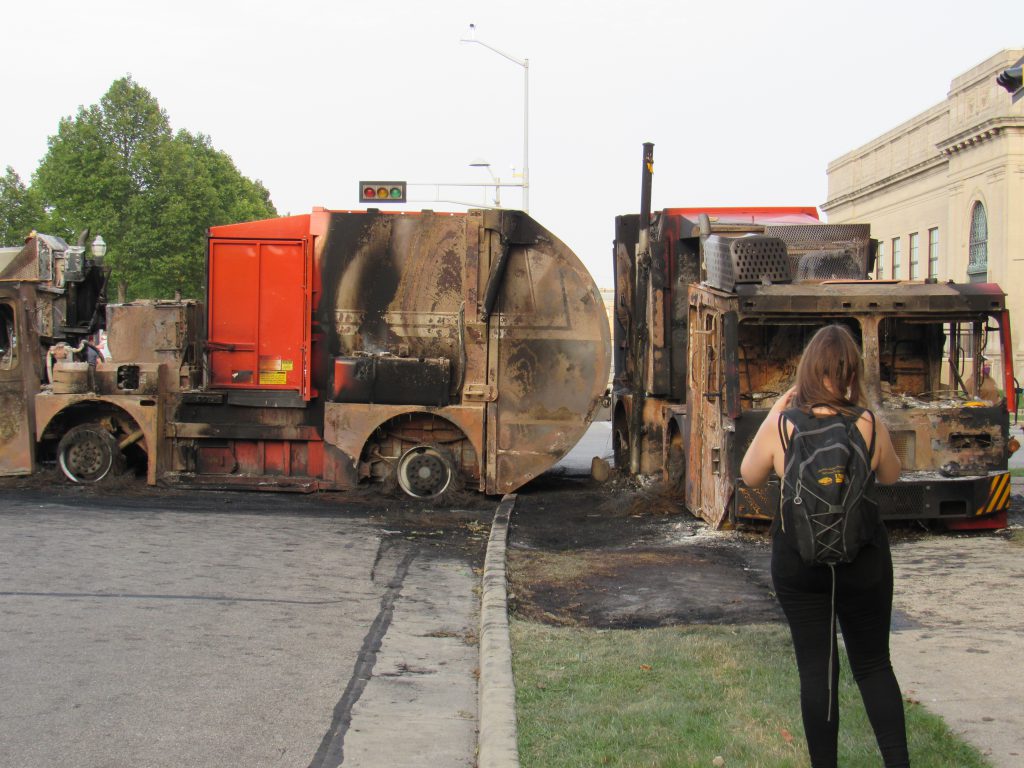
Protesters gather in Kenosha the second night of protests on August 24th, 2020. This was before the clashes with police later that night. Photo by Isiah Holmes/Wisconsin Examiner.
Deltgren received a ticket for violating the curfew — a misdemeanor. However, if she gets into any trouble, police told her, even a traffic ticket, then the violation turns into a felony. She opted to lay low in Milwaukee until he court date, or until the ticket is paid. Akindes’ bail was set at $200, though paying it didn’t buy her release until several hours later. Deltgren felt that the officers and soldiers grabbing people were treating the arrests as sport.
“They were treating it as a game,” she recalled. “When I was sitting in there they were like, ‘Yeah I was able to snatch up like five people last time.’ They were playing it like a sport, literally describing it as ‘snatching people up…’ There was absolutely no remorse towards protesters, towards the whole situation.”
Both Deltgren and Walton noted that no militia members were taken into custody as far as they could tell, and most of the detainees wore BLM clothing, or were simply people of color. The curfew ended after a group of lawyers threatened a class action lawsuit against the city of Kenosha.
“We believe that the Kenosha Police and Kenosha Sheriff have used the curfew ordinance to silence the voices of those who peacefully demonstrate against police brutality while also allowing pro-police activists and militias to roam the streets without fear of arrest,” read a statement from Motley Legal.
Hersey finds it difficult to reconcile the way officers operated during the curfew with any idea of patriotism or duty. “As a veteran myself, I’m angry. Because I fought for my country, just like they’re fighting for their country,” says Hersey, who adds, “I understand they have orders. I get that.” Nevertheless, she wonders where the line is between following orders and respecting citizens’ constitutional rights.
Walton feels that the response by police shows how much power the Black Lives Matter movement actually has gained.
“I think it just shows how scared the justice system really is, and how much power people actually have,” said Walton. “Because if they keep the people silent, then they move around here untouched. But when the people are binded together, and they’re making their voice into one loud voice, and they’re making the world pay attention, then they have no choice but to be held accountable.”
Reprinted with permission of Wisconsin Examiner.
More about the Kenosha Unrest
- Kenosha Event Revisits 2020 Unrest - Isiah Holmes - Aug 30th, 2022
- WisGOP Statement on One-Year Anniversary of Kenosha Violence - Republican Party of Wisconsin - Aug 24th, 2021
- One Year After Jacob Blake Shooting Kenosha Seeks Answers - Isiah Holmes and Henry Redman - Aug 23rd, 2021
- Tony Evers Lies on Kenosha Record - Republican Party of Wisconsin - Jun 14th, 2021
- Coins Celebrate Policing of Kenosha Protests - Isiah Holmes and Henry Redman - May 18th, 2021
- Did DA Delay Mensah Decision Due To Kenosha Unrest? - Isiah Holmes - Apr 8th, 2021
- How U.S. Marshals Came to Kenosha - Isiah Holmes - Apr 5th, 2021
- Wisconsin Man Indicted for Injuring Police Officer During Kenosha Riots - U.S. Department of Justice - Jan 27th, 2021
- Prosecutors Want Court to Ban Rittenhouse from Bars - Corrinne Hess - Jan 14th, 2021
- Kenosha DA Won’t Charge Cops in Blake Shooting - Corrinne Hess - Jan 5th, 2021
Read more about Kenosha Unrest here
More about the Shooting of Jacob Blake
- No Federal Charges For Officer That Shot Jacob Blake - Madeline Fox - Oct 8th, 2021
- Federal Officials Close Review of the Officer-Involved Shooting of Jacob Blake - U.S. Department of Justice - Oct 8th, 2021
- WisGOP Statement on One-Year Anniversary of Kenosha Violence - Republican Party of Wisconsin - Aug 24th, 2021
- One Year After Jacob Blake Shooting Kenosha Seeks Answers - Isiah Holmes and Henry Redman - Aug 23rd, 2021
- Gov. Evers Releases Statement One Year After Jacob Blake Shooting - Gov. Tony Evers - Aug 23rd, 2021
- Kenosha Activists Arrested During Protest of Jacob Blake - Henry Redman - May 6th, 2021
- Body Cameras Key To Charges Against Police - Corrinne Hess - May 4th, 2021
- Wisconsin Police Donated to Officer that Shot Jacob Blake - Jenny Peek and Corrinne Hess - Apr 16th, 2021
- Kenosha activists respond to tonight’s Officer Sheskey announcement - Leaders of Kenosha - Apr 13th, 2021
- Kenosha Police Department Statement on Officer Rusten Sheskey’s Return From Administrative Leave - Kenosha Police Department - Apr 13th, 2021
Read more about Shooting of Jacob Blake here





















